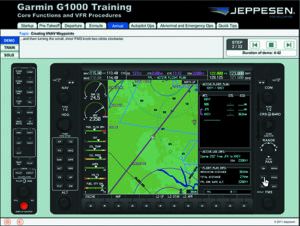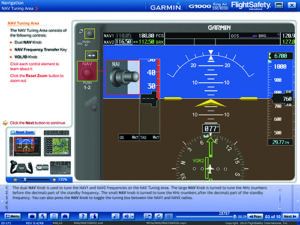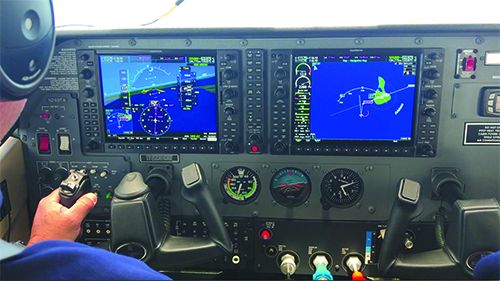In the July 2019 Aviation Consumer I rounded up the top electronic study courses for earning the private pilot certificate. But since some of the initial or advanced training might be accomplished in a Garmin G1000-equipped airplane, for this article I went on the hunt for the top electronic supplemental study aids to ease the learning curve.

And even if you’re a seasoned pilot making the transition to a G1000 from traditional flight instruments and stack-mounted radios there will still be a lot to learn. Here’s a market scan of the most comprehensive electronic study aids focused on the G1000 system.
JEPPESEN
Jeppesen’s Garmin G1000 VFR & IFR Procedures courses are scenario-based, interactive courses. The courses use an interactive G1000 simulator to guide the student through real-world scenarios for using the system. The VFR and IFR courses are offered separately or as a bundle. Both use the same format, which organizes sections by phase of flight. Each section is then broken down into a series of lessons and tasks to be completed on the simulator. The simulator mimics a typical G1000 setup in a Diamond DA40—the first airplane with the G1000 on its type certificate.

Lessons include a demonstration section, which explains the system features and tasks and provides a visual walk-through on the simulator. For most lessons, the student can then click to a Train page. In Train, directions are provided for the completion of the listed task. A Solo page is also available, which has the student perform the directed task without assistance. Incorrect actions are flagged and lesson credit is awarded for completing Solo tasks with an acceptable number of errors. Lessons can be viewed in any order and the course reopens on the last completed lesson. A progress tracker lists what percentage of the course has been completed.

The VFR course covers operations from startup through arrival. It also offers sections on autopilot and abnormal and emergency operations. Lessons are available on TIS, TAWS and G1000 weather. The IFR course covers departure, enroute, WAAS and approach scenarios. Both courses have sections on common mistakes and tips for using the G1000.
Each course ends with a 20-question exam. Questions can be marked for follow-up and answers can be reviewed with attached explanations after the exam. A passing score for the exams is 80 percent. Exams can be retaken and questions vary with each attempt.
After taking the courses, I think Jeppesen’s Garmin G1000 VFR & IFR Procedures are a great resource for pilots looking for a hands-on way to familiarize themselves with the system before getting into the airplane, and equally as good for reviewing once you’ve gained some experience. The procedure-based training provides good practice for real-world scenarios and the lessons are clear and well-presented. While not flawless, the Jeppesen G1000 simulator is very good. It accurately mimics the G1000 system and gives pilots a chance to get some hands-on time with the equipment before trying it out in the airplane.
If I had a nit to pick it would be that the courses could be improved by making it easier to identify completed lessons, but that’s minor.
The bigger issue is that Jeppesen’s courses do not support tablet use. The VFR procedures course is $119.96, and the price for the IFR procedures course is $109.96. Bundled together, the VFR & IFR Procedures courses are $199.96.
FLIGHTSAFETY G1000 FOR KING AIR 200/300
FlightSafety International’s Garmin G1000 for King Air 200/300 Series eLearning course is also an interactive, situation-based program. As the title implies, the course is designed to cover G1000 features and functions as installed in the King Air 200/300 series—a popular retrofit for these airplanes. The course includes VFR and IFR operations and the course duration is approximately 11 to 13 hours.

The course is organized into 19 modules plus a course introduction. Mandatory sections are marked on the course menu as are completed modules and sections. Each module is divided into sections, which are organized by topic. Each lesson includes audio explanations with associated visual demonstration. Modules can be completed in any order, but all mandatory sections must be completed to finish the course.
Periodically throughout the modules, the student will be asked to complete a task on the interactive G1000 simulator. These start with a task demonstration followed by guided walk-through practice sessions, called Try it. Once Try it has been successfully completed, a knowledge evaluation has the student perform the task without hints. Check Your Understanding (CYU) sections also appear in the modules. CYU question options include multiple choice, matching and system control identification.
Modules cover topics including situational awareness, the synthetic vision system, emergency and abnormal procedures, and G1000 hazard avoidance tools like the Traffic Information System (TIS), Terrain Awareness and Warning System (TAWS) and GDL 69A XM Satellite Weather. The last module is a Final Scenario during which the student must perform a series of procedures in a real-world scenario beginning at startup and ending with reloading an approach after a missed approach. There is no demo provided for Final Scenario tasks.
The course provides a glossary where terms can be looked up alphabetically or searched for. A notepad function is available where notes can be taken for the overall course or specifically for any page of the course. Notes can also be copied and saved on the computer and/or printed. A Help button provides a Course Quick Tour option and allows students to email learning procedure or system operation questions to a learning management system administrator. An Email button lets students email questions to a subject matter expert. And a Bookmark option lets students bookmark a screen. All audio is closed captioned with a transcript box provided. The entire course is also searchable. Additional course resources include PDF files on updating Garmin and Jeppesen databases, the traffic advisory system and activating XM services.
FlightSafety International’s Garmin G1000 for King Air 200/300 Series eLearning course offers a thorough, in-depth and well-developed program. The regular use of interactive components and what are essentially G1000 simulator lessons is highly effective and creates a top-of-the-line learning experience. As a side note, the course also pays good attention to how its 2D representations might differ in appearance from the actual equipment including showing multiple-viewpoint images for better real-life identification.
The course interface is complex, but a good introductory module/course tour successfully explains the graphic user interface, course navigation and interaction with the course’s simulated environment. One minor drawback is that it is not designed for use on mobile devices. Our only significant issue with this course is the price, which comes in at $620 for one year access.
SPORTY’S G1000 CHECKOUT
The Sporty’s Garmin G1000 Checkout course is made up of 17 video lessons that review both VFR and IFR scenarios. The course primarily uses Cessna Nav III aircraft to demonstrate and the lessons are organized by topic. In addition to introducing the basics of the G1000, the course offers two good cross-country walkthroughs—one for VFR and one for IFR—along with lessons on emergencies and possible variations in G1000 systems. Total runtime for all of the videos is a little over two hours. They can be viewed in any order.
The course concludes with a 35-question final review quiz. Answers can be reviewed after the quiz is graded and the quiz can be retaken as often as desired. Questions are selected at random from a question bank and will vary each time the quiz is taken. A course completion bar tracks course progress and a progress report logs review quiz scores and answers.
Additional resources provided as part of the course include a G1000 syllabus and instructor guide. The lesson breakdown in the syllabus and guide includes completion standards and lists of common errors, which provide good add-on information and further framework for the course. A Cessna Nav III cockpit reference guide, which can be downloaded or viewed online, is also part of the package.
The Sporty’s Garmin G1000 Checkout course is compact, well-organized and offers great, informative HD videos. The Closer Look lessons, which cover specific features in greater detail, are a standout addition to the course. Closer Look topics include weather resources, checklists and charts, synthetic vision, Garmin Connext and GFC 700 autopilot. Course navigation is straightforward and easy to use. The course could be improved with more regular assessments throughout the course and interactive features.
In addition to computer access, the course can be taken on the Sporty’s Pilot Training app for both iOS and Android systems, AppleTV and RokuTV. Course progress will sync between devices. A course completion certificate is available once video training has been completed and a review quiz passed with a score of 80 percent or better. Cost for the course is $99.99 for lifetime access. It is accepted for FAA WINGS credit.
KING SCHOOLS FLYING THE GARMIN G1000
The King Schools Flying the Garmin G1000 course comprises 12 labs, each of which includes a series of video lessons ranging in length from a couple of minutes to over twenty. The course covers both VFR and IFR operations with the G1000 and the labs are organized by topic and type of flight. The King course does not take an aircraft-specific approach, instead pointing out that students should take time to familiarize themselves with the exact system they will be using. There are seven hours of video lessons in total, which can be viewed in any order.
Overall, the course is a very good introduction (or refresher) to using the G1000 during both VFR and IFR operations. The videos are engaging, well-paced and easy to understand. There are some particularly good discussions of how to transition from round gauges to glass. It goes beyond the basics to cover a lot of G1000 features and options like how to use the Garmin GFC 700 autopilot, WAAS, XM weather, Terrain Awareness and Warning System, Traffic Information System, SafeTaxi, FlightCharts and G1000 checklists. It offers separate labs for how to handle G1000 failures in VMC and IMC, which we felt was an important and well-handled distinction. It’s easy to see which labs have been completed and to navigate to different areas of the course. The course could be improved by providing some kind of assessment tool for users. It’s video-only and does not offer any interactive features, quizzes or tests.
The course can be accessed via computer or on iOS devices using the King Schools Companion app and course progress will sync between devices. The app allows users to download the course for offline viewing. A completion certificate is available once all of the labs have been completed and it is accepted for FAA WINGS credit. Cost for the course is $179 for lifetime access.
VIRTUAL POH GARMIN G1000 ONLINE TRAINING
The Garmin G1000 Online Training system from Virtual POH is an interactive G1000 demonstrator coupled with audio briefings. The course provides visual demonstrations on a virtual G1000 to go along with the audio lessons, which are organized by topic and separated into PFD and MFD briefings. The interactive demonstrator allows students to both follow along during demonstrations and reproduce system tasks.
The course is VFR-focused and not aircraft specific. There are about three hours’ worth of audio content, but the demonstrator can be used separately. Hovering the mouse over a demonstrator button or knob will pull up a short description of its function. Briefings include general and page-specific system operations along with traffic, weather and terrain awareness capabilities. An XM radio briefing is included.
In general, the course is simple, but effective. It is geared toward beginner students who are not familiar with the G1000 system. It covers some good basics such as how to clean the screens and maintain the system that we didn’t see in other programs. This was the only course we reviewed where the interactive component could be used freely, which is a great benefit to learning the system.
While a good resource for students working to get a handle on the basics, this program is not particularly designed for pilots looking to develop a complete understanding of the G1000’s capabilities. The demonstrator is not a fully functioning representation of a G1000 and there are some tasks it can’t perform. There are no progress trackers and the course does not cover abnormal and emergency operations.
Course navigation is trouble-free and the demonstrator functions smoothly and intuitively. The course runs $99 for 12 months. It is iPad compatible.
PILOT LEARNING GARMIN G1000 VFR AND IFR
The Pilot Learning Garmin G1000 VFR and IFR (non-WAAS) courses are designed and presented by 2008 National CFI of the Year Max Trescott. Both courses are divided into sections and each section includes a series of video lessons. The lessons—51 for VFR and 40 for IFR—are organized by topic and do not focus on a particular aircraft model.
Videos average between five and fifteen minutes. Short scenarios are periodically included in lessons to cover related G1000 tasks. Lessons can be viewed in any order and are marked once completed. A course progress tracker appears at the end of each section and a counter displays the number of lessons completed.
Beyond standard use of the G1000 system, the VFR course includes lessons on G1000 terminology, traffic, weather and terrain along with G1000 checklists, autopilot interaction and malfunctions. It also reviews the advantages and disadvantages of a glass cockpit system compared to round gauges. The VFR course ends with a video following typical G1000 use on a Cessna 172 flight from preflight preparation to shutdown. In addition to covering G1000 use for IFR departure, enroute, arrival and approach procedures, the IFR course has lessons on glass cockpit instrument scans, holding, flying a DME arc and using OBS mode. Additional features include a searchable glossary (VFR) and weekly progress reminder emails for active courses.
Overall, Pilot Learning’s Garmin G1000 VFR and IFR (non-WAAS) courses provide a solid, well-delivered introduction to the system. Video lessons are clear, concise and organized into easily watchable lessons. There is good focus on system limitations and common areas where pilots get stuck with the G1000. Course navigation is clean and simple, although the courses could be improved by providing assessment tools.
The courses are designed for viewing on a computer but can be accessed via mobile devices with an internet connection. The Garmin G1000 VFR course and Garmin G1000 IFR (non-WAAS) course cost $59 each. A separate Flying WAAS and GPS Approaches course is offered for $79. Monthly and yearly membership options are available, which include access to all three courses during the specified time period. Membership fees are $29.95 per month or $299 per year.
GOLD SEAL
The Gold Seal Online Ground School has the Garmin G1000 Checkout course, which is VFR-focused and interactive. The cost is $47 for one year access. We didn’t cover it in detail here because the company asked to not participate in our roundup. If you have experience with this course we want to hear about it. For now we can’t recommend it.
TOP PICKS
For G1000 courses, we have a strong preference for the interactive editions. Selecting the best of those was no easy task. FlightSafety International’s Garmin G1000 for King Air 200/300 Series eLearning course offered the most thorough program coupled with an effective watch-try-do teaching method and a tidy, bug-free G1000 simulator.
It also provides the widest array of helpful features. It’s a worthy course geared toward professional pilots, but the price (and King Air focus) puts it in a separate category from the rest.
If you plan to transition to a G1000 King Air, we think it’s a must-have study course.
For those looking for a G1000 learning experience geared more toward single-engine piston general aviation flying, Jeppesen’s Garmin G1000 VFR & IFR Procedures courses are our top pick.
The interactive lessons use a similar—and highly successful—watch-try-do format and there’s great depth to all of the topics presented.





